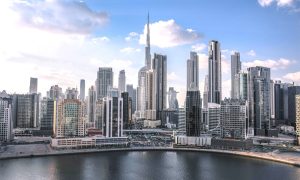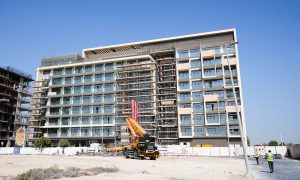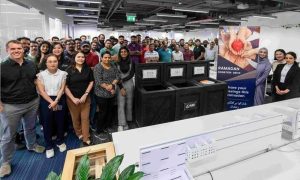Solid fundamentals
Alstom Transport has invested in customer proximity, integrated product offerings and technology leadership to grow its rail business worldwide

Alstom Transport has invested in customer proximity, integrated product offerings and technology leadership to grow its rail business worldwide
According to Henri Poupart-Lafarge, president, Alstom Transport, the fundamentals driving the global railway market – urbanisation, sustainable development, economic growth and public funding – have remained unchanged for the past two years, and are not expected to change in the future.
“The increase in the number of cities and their population is creating the need for urban transport as well as intercity transport between large cities,” said Poupart-Lafarge while speaking to the press during Innotrans 2014 in Germany recently. “Focus on sustainable development is leading to commitments favouring rail, which is seen as one of the most environment-friendly modes of urban transport.”
Tansportation systems have always been crucial drivers of economic growth and vice versa. This is especially applicable to emerging countries where economic and demographic growth is creating a growing demand for infrastructure, trains and signalling. Mature markets, on the other hand, are mainly supported by projects aimed at updating and modernising existing infrastructure, as well as by growing environmental concerns.
Last but no less important is government support. Poupart-Lafarge explained: “No public transport or rail transportation system in the world works today without some form of subsidy or public funding.”
But he also pointed out that a slow global economic recovery could be a limiting factor, at least in the short term as governments turn their attention to controlling deficits. Economic growth has slowed not only in Europe, but also in some emerging economies like Brazil and South Africa.
“Though governments are still pushing for investments in public transportation, lack of public finance is an impediment to the development of projects,” said Poupart-Lafarge. “While the situation hasn’t fundamentally changed from a long-term perspective, we see more challenges in the short term.”
UNIFE’s mid-term forecast sees steady annual growth averaging around 2.6-2.7% over the next six years. While main line markets remain the largest, demand in coming years will be focused on the urban sector, and more so in emerging countries where urbanisation is a major trend.
These new markets are also showing a strong demand for turnkey systems, defined as a combination of infrastructure, power supply, track systems, rolling stock, signalling and the system to make them work together. The proportion of urban systems tendered and delivered as turnkey is as high as 80% in the Middle East and Africa and 50% in Latin America.
“In rolling stock, the fastest growing segment is urban systems, thanks to the urbanisation trend,” said Poupart-Lafarge. “If you combine urban segment and emerging economies, you could reach growth rates of 6-8% per annum.”
Apart from urban systems, the other growth segments are services and signalling. In the case of services, the major drivers outlined by UNIFE are the growth in installed base and outsourcing of services by rail operators. The drivers of signalling are investments in new urban lines and the modernisation of existing lines.
According to Poupart-Lafarge, what sets Alstom apart in the rail industry is its strong presence in all segments, right from rolling stock (trams, high speed trains) to systems (infrastructure and turnkey) to services (spare parts, modernisation and long-term maintenance), to signalling.
“Over the years, the share of rolling stock has been balanced out by growth in other activities, to the extent that rolling stock represents only half of our activity. This is part of our long-term strategy, which we will continue to follow.”
Currently, rolling stock accounts for 49% of sales, with the rest equally split between signalling, services and systems.
Geographically, Alstom Transport’s markets are split into seven regions: France, Europe, North America, Latin America, Asia/Pacific, the Commonwealth of Independent States and the Middle East/Africa.
According to a UNIFE 2014 report, Europe (excluding France), which represents about a third of the global rail market, is expected to grow – thanks to major projects underway or in the pipeline like Grand Paris, London Underground and HS2 – but at a slower rate. The market is forecast to grow from €32bn to nearly €35bn per year from 2011-2013 to 2017-2019, an annual growth rate of 1.6%.
But the regional markets with the highest growth rates over the next six years will be Latin America, Asia/Pacific and NAFTA. Latin America is the market with the strongest growth, due to the large number of urban projects, while North America is witnessing growth on the back of freight and urban systems, in this case light railways.

Dubai Tram: The Citadis tram is the first in the world capable of operating in temperatures of up to 50 °C and to withstand harsh climate conditions
The Africa/Middle East region is expected to maintain its current high market level in coming years, with the market forecast to grow from €8bn to €9bn per year from 2011-2013 to 2017-2019, an annual growth rate of 2.2%.
Competitive strategy
In his address, Poupart-Lafarge also provided a glimpse into the strategy which has enabled Alstom Transport to develop close proximity to its customers. The strategy is based on the four pillars of customer-focused geographical footprint, integrated solutions, technology and innovation, and operational excellence.
Alstom has been able to develop both a local and global presence, which has helped differentiate the company from competition. “Our customers require localised and tailor-made solutions, so we have to be located close to them,” said Poupart-Lafarge. “We are physically present in all large markets across all continents, either directly or through partnerships.”
These partnerships, whether joint ventures or strategic and commercial partnerships, enable Alstom to meet customers’ growing demand for local presence while developing products and solutions that are better adapted to local specificities. Alstom Transport’s key partnerships include TMH in Russia, CITAL in Algeria and GIBELA in South Africa.
“We are not averse to partnerships, because we understand the way to market differs from one region to another,” said Poupart-Lafarge. “In fact, partnerships is one of our key competencies.”
The company has also invested in building up its services business to strengthen its relationship with its customers. The Alstom chief elaborated: “Service activity is of utmost importance, because it helps us build local presence and develop customer intimacy. We don’t believe in building turnkey projects and walking away. Rather, we believe in working with our customers day-to-day, hand-in-hand. We have maintenance activities in more than 28 countries.”
The second strategy is to provide a complete range of integrated solutions that address all levels of integration that customers may seek. These range from a single sub-system, to solutions integrated within a single market segment (like the Coradia Continental trains specifically developed for Europe), to bundled offers between two market segments, to full turnkey systems (like Riyadh Metro).
Poupart-Lafarge added: “We have developed turnkey systems in-house; in other words, we are not just implementing turnkey solutions on a case-by-case basis, we are sold internally on how to best design the turnkey solution.”
For example, Alstom Transport developed Axonis, a turnkey elevated metro system that meets the demands of cities looking for system solutions that can be installed quickly and easily while providing an optimum life-cycle cost. Axonis’ energy consumption is 30-40% lower than similar systems.
“This is also extremely important to value the quality of our products,” said Poupart-Lafarge. “We aim at producing products that have the best efficiency in terms of TCO during their lifetime, in terms of energy efficiency and maintenance cost.”
The third pillar is differentiation through innovation and technology. “We are driven by innovation, but one thing which has changed is that we are not looking for absolute speed. Rather, we are looking to improve the efficiency of our systems, particularly environmental performance or capacity.
“For example, our new Urbalis Fluence signalling solution, implemented in Lille Metro, helps reduce headways down to as little as a minute through the use of direct train-to-train communication, which helps increase metro capacity.
“We are also focused on reducing the TCO, for example through recyclability. Thus, our latest rolling stocks are minimum 95% recyclable, which helps tackle the end of life of the products.”
On the environmental performance front, Alstom Transport and Deutsche Bahn have jointly launched hybrid shunting locomotives that consume up to 50% less fuel than conventional ones and reduce pollutant emissions by up to 70%. Alstom has also signed Letters of Intent to develop a new generation of diesel trains based on fuel cells with near zero emissions. Additionally, Alstom Transport is also developing new technologies to address new markets.
Commenting on the fourth pillar of operational excellence, Poupart-Lafarge said that his company has implemented d2e, an internal programme dedicated to excellence, and a number of sub-programmes aimed at improving operations.
“We are here to satisfy our customer, which means we need to deliver on time, at the right cost and quality, and be competitive. If you want to be the most global company in transport but also deliver the same quality from all the facilities across the world, whether it is Brazil, India or China, the customer has to have the guarantee that the quality will be the same. For that, we have extremely strong global processes. The idea is not to have a different footprint with a different type of quality and technology, but to have a single Alstom Quality worldwide.”
Worldwide demand for mobility is growing steadily with demographic change, urbanisation and economic development. As one of the only global integrated players in railway systems and solutions, Alstom Transport’s unique market position is expected to be further enhanced by the acquisition of GE’s signalling business (as part of GE’s acquisition of Alstom’s power business). This will strengthen Alstom Transport’s balance sheet and catapult the company to global number two in the signalling business, leaving it with a stronger portfolio to tap the worldwide growth of the rail transport market.


















